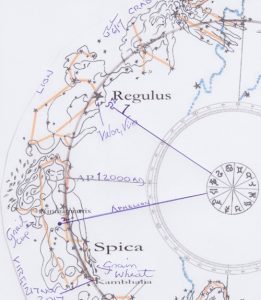Celestial Optics
Stories That Live in Psyche and Sky
Detail of a working model of four constellations
This draft from 2017 is one of hundreds of hand-drawn studies of the Rimsite developed over decades to achieve exact star locations relative to signatures and graphics (defined below).
The circle on the right shows the 12 astrological signs indicated by their familiar symbols. Arrows indicate the precise locations of prominent stars relative to the starless register of signs. Celestics encourages hands-on and eyes-on engagement with the zodiacal images. Study of the details in the Rimsite can be enhanced by naked-eye observation. The Rimsite is also an accurate guide to skywatching.
The Art of Visualization
Note the star-to-star signatures of the constellations in orange. The inverted Y for the Crab does not immediately suggest a visualization to match that creature. You have to be taught how to picture the graphics. In doing so, the Celestician references a range of figures drawn from diverse cultures around the world. The signature of the Lion roughly suggests the graphic rendering of that constellation. The head and mane, the crouching or leaping body, including the tail marked exactly by a star offer a loose match to the visualization.
Celestics shorthand indicates the tail star in this way: Denebola, beta Lionis @ 173° ↔ 23 Virgo. 173° is the location of that star on the 360-register of the sky (ecliptic longitude), similar to a circular ruler or protractor. In the signframe 173° is 23 Virgo, the sixth section of the starless zodiac. Once again, you see the difference between the visible star-patterns of the constellations and the starless signs.
The Lion can also be pictured as the Plumed Serpent, Quetzalcoatl. Notice how the plume of the serpent matches the mane of the Lion. Also, how the heart-star of the Lion matches the throat of the serpent. That star is Regulus @ 151 ↔ 1 Virgo, renamed Vira, “prowess, heroic strength.” The Lion/Quetzalcoatl is the real-sky zodiacal image of the nobility of the warrior class. The name Vira, also spelled Virya, comes from the IE root, vir-, referring to both man (virile) and woman (virgin, virago). Imagine your birthday is August 23rd when the Sun is conjunct Vira, and a conventional astrologer advises you on the karmic tendencies typical of a Virgoan personality. Such an interpretation would (at best) offer you a veracious profile of your Virgoan talents and tendencies, but it would tell you nothing whatsoever about the deep foundation of your transpersonal endowment. It would not and could not guide you on how to compose your life-narrative based on the scripting template of the Lion, and place yourself in the role of heroic nobility. 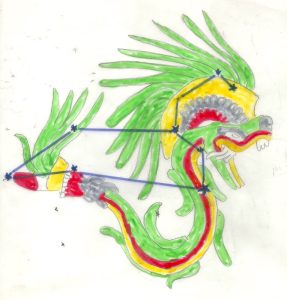
Of all the 13 major constellations, only the signatures of Snaketamer and Scorpion vividly suggest to the observer the graphic renderings assigned to them. Boundaries between constellations are a topic of intensive study and meticulous observation. In some cases, they are particularly hard to define. For instance, in the hand-drawn graphics above, the head-stars of the Twins, Castor and Pollux, seem to meld into the amorphous body of the Crab. Traditional nautical lore associates the ambiguous region around the head of the Twins with St. Elmo’s Fire. This is an electrical haze that engulfs the masts of sailing vessels. The composite stars of Twins and Crab merge, but scan down and you see a considerable gap between the Crab and the Lion. The extended paw of the Lion appears to reach out to the right claw of the Crab — that is a deliberate design feature of the graphics. In actual viewing, there is a discernible empty space of about seven degrees between the two composites.
The boundary between Lion and Virgin is more distinct. It can be identified by the prominent tail-star of the Lion, Denebola. That is the boundary star between the Lion and Virgin. There are no distinct stars in the face of the Virgin, but Vindemiatrix @ 190° ↔ 10 Libra stands exactly at the Grail Cup held in her right hand. Off her right shoulder, the seed-like marks scattered in her hair represent the enormous cluster of galaxies at the super-galactic north pole, called the Virgo Supercluster. In Greco-Latin tradition this area was called Coma Berenices, but it does not form a constellation with a distinct signature. The hair of the Virgin is literally seeded with hundreds of galaxies.
The notation AP 2000 AD refers to the current position of the autumnal point (AP) where the Sun stands on the first day of fall. We live in an age when the AP stands at the exact place where the Virgin’s face is unmasked. This is the moment of lifting the “Veil of Isis.” A statue at the ancient sanctuary of Sais in Egypt carries this inscription: “I am all that has been and is and shall be; and no mortal has ever lifted my veil.” This is evidence from remote times encoded in the celestial writing that becomes for us today a meme to be applied in forensic investigation of the manifold. That line may be encrypted in your life-narrative. Imagine if you knew that and learned how to compose your life-narrative on that theme.
Note the star Kambhalia at the knees of the Virgin. This is lambda Virginis @ 218° ↔ 8 Scorpio, situated in an ambiguous zone between the Virgin and the Scales. Mysteriously, it is called the Alchemist’s Star. Celestics inserts a minor constellation in this area, the Cache or Treasure Chest. This new constellational image is not arbitrary, not a make-believe flourish with no basis. It comes from years of star plotting combined with studies in comparative mythology, and naked-eye observation. Celestics is a forensic method that identifies and investigates themes and narratives in the code bank of zodiacal imagery. You may have the Sun, Moon, or a planet at 8 Scorpio in the Cache, but the astrological data does not encode the biographic evidence that you find in the manifold tables and Rimsite projections. You cannot actually see what Moon in 8 Scorpio in the 12th house means, but you can see it in the real-sky graphics.
In the Rimsite you find the optical evidence of your unique treasure, called the endowment. This evidence reveals how you compose, or can compose, your life-narrative. Learning how the story you tell yourself about your talents and goals in life directs what you do, you acquire a transcendent perspective that connects you to the human species as a whole. It shows you what you are, beyond who you are. Humans are story-telling animals. We behave as we believe, but all beliefs are encrypted in stories. Your behavior follows the story-line you construct about it.
The Ecliptic Plane
The difference between signs and constellations is not a big challenge to learn, although it is a big deal to know that difference. Many professional astrologers are oblivious to it, and almost all of their clients naively assume that their sun-sign, be it Cancer, Scorpio, or whatever, identifies a pattern of stars in the night sky. But it does not. That is the real-sky or stellar zodiac that can be observed with the naked eye. They are also called ecliptic constellations, for obvious reasons which I’ll continue to emphasize. But, and this is an emphatic but, they are not identical with the twelve uniform ecliptic sectors of the signframe. What is the difference?
The portal page, Introduction explains how you can see the constellations by observing the night sky, then picture them in your mind and render them in art. But can you see or picture a sign? Absolutely not, but you can illustrate what a sign is by a typographic notation, like this: [ ]. The brackets are the boundaries of a sign that register the extent of ecliptic longitude from 1° to 360°. Here is the expanded notation for Cancer, [90 °—————Cancer–x————-120°]. Each hyphen represents one degree of the sign. X marks 18° Cancer. What do you see between the brackets? Nothing. No one can actually see a sign. Signs are invisible, like the time zones around the Earth, the spaces between the marks on a measuring cup, or the sections on a circular ruler, a protractor. You see the extent of space between the measuring marks, but there is nothing in that space. If you are born with the Sun at the one-degree mark of the sign Cancer, there is no star-pattern to observe. 1° Cancer is merely a measure on a calibrated grid.
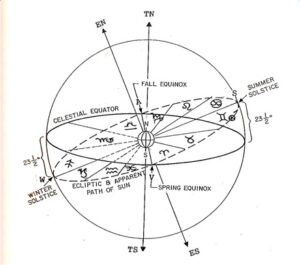
Standard model of the ecliptic divided into the 12 signs, with the celestial equator, solstices and equinoxes, and the north and south terrestrial poles (TN and TS). TN points to Polaris
The sequence of the starless zodiac starts at the spring equinox, degree 1 of Aries or 001° on the ecliptic. It runs counter-clockwise through Taurus, Gemini, Cancer, etc. This circle can be measured using twelve equal 30-degree sectors, or using the full register from 1° to 360° of ecliptic longitude (ECL). At the summer solstice when the Sun reaches its highest point in the sky, it crosses from the Gemini sector to the Cancer sector. 90° = 30° Gemini, ECL 91° = 1° Cancer. The summer solstice occurs at the 90°/91° crossover line in the signframe. Make sure you can find it on the model.
The model above is the only illustration from the realm of astronomy that you need to know in Celestics. Picture it as a transparent glass construct enclosed in a sphere of glass. Internally, it has two intersecting plates, the celestial equator (projection of Earth’s equator into the heavens) and the ecliptic plane (projection of the terrestrial orbit, the apparent path of the Sun). Although stars surround Earth in all directions, there are no stars in this model. The ecliptic-equatorial structure is entirely independent of reference to stars. Each pizza-slice-like sign on the ecliptic plane, such as Scorpio ECL 210° – 240°, is an abstract location zone that completely ignores the surrounding environment of the starry heavens.
Conversion to StarBase
The group of constellations located along the perimeter of the ecliptic are the principal material of Celestics. It comprises thirteen major figures, a vacant zone, two minor constellations, as well as six marginal zones at the boundaries of adjacent constellations. (See MANIFOLD.) All these areas of the observable sky have narrative features that translate into plot-lines, themes, and motifs for scripting your life-narrative by the method of forensic astronomy.
Conversion to StarBase begins with the same data used for constructing a horoscope: year, month, day, minute of birth, plus the longitude and latitude of the birthplace. If your horoscope comes from an astrologer or an IT generator on the internet, you get something like this:
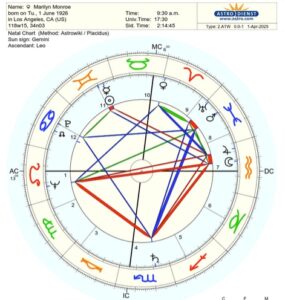
Horoscope of Marilyn Monroe
Once again, bear with me while I explain what you are seeing as I previously did in the Introduction. It matters to me that newcomers to Celestics are confident in knowing what the horoscope shows, even without understanding what it means. That confidence prepares you to appreciate the novel features of forensic astronomy. It also emphasizes the difference between the two systems: With astrology you rely on an expert to decode the meaning of your horoscope, with Celestics you discover for yourself what the manifold reveals.
Let’s review the four components of the horoscope: houses, signs, planets, aspects. In the format above (Placidian house-system), the wheel of the twelve signs overlays the houses as if it were a transparent plate. The signs are all uniform, 30 degrees each in extent. The houses are uneven, 6, 7 and 8 being notably smaller than 10, 11, and 12. These variations are due to the baroque math of spherical trigonometry used to represent the spatial perspective around the birthplace on a flat plane. They are not actual features of the cosmos. The differing extents of the houses are like the curves in a funhouse mirror that distort your reflection. In some formats, the houses are uniform and the signs uneven (“intercepted signs”). The planispheric projection introduces Photoshopped type artefacts into the horoscopic structure. Astrologers routinely attribute nuances of significance to these distortions. Imagine an eye doctor who sees your funhouse mirror face with a different shape and size for each eye, and so recommends that you get corrective surgery. Formatting in Celestics eliminates all stereomorphic distortions.
On to the planets. Each planet occupies the sign/house overlay: Neptune in the 1st house in Leo, nine o’clock position on left. AC or ASC is the ascendant or rising sign. That is the point due east on the local horizon where the Sun rises. DC opposite is the descendant where the Sun sets. The planets rotate clockwise through the houses in the course of a day. You see the Sun high in the 10th house in Gemini. It is close to the boundary of the 11 house, thus, “on the cusp of the 11th.” Astrologers make a big deal of these formatting details. This position tells you that Monroe was born late morning in the summer when the Sun was already high. You see the Moon and Jupiter in the 7th house in Aquarius close to the descendant, due west. That tells you that the waxing Moon was setting at the time of her birth, but would not have been visible due to the strength of daylight.
Finally, the aspects. These are angular relations between the planets, shown here by colored lines. The blue line from Venus at 29 Aries/h10 to Neptune at 23 Leo/h1 indicates a trine of 120 degrees of separation, but it’s six degrees from exact. Not all aspects are shown in this example. For instance, the Sun at 12 Gemini/h10 stands ahead in the zodiac at 72 degrees from Neptune in 23 Leo/h1. 72 degrees is the distance in longitude measured on the orbital plane of Earth. In full register notation, Sun @ 72° to Neptune @ 143° = 71 degrees. That is a near-exact quintile aspect (1/5th of a full circle) indicating a factor of genius, a high level of creative articulation, or exceptional gifts for self-expression. Neptune is the planet of glamour and the spell of visual and cinematic media. Monroe was an international “sex symbol” and world-famous actress. Clear enough? Yes, but hold on a second.
CAVEAT
Celestics does not rely on the theory of astral determination. It does not follow the theory that stars and planets cause human behaviour. The Sun-Neptune quintile in Monroe’s natal template did not make her become what she became, or make her anything at all. Countless others have that quintile situated in other sign/house overlays — in 144 variations! — and they do not become glamorous movie stars. Remember, the Celestics format of the sky excludes, signs, houses, and aspects. It also excludes the assumption that your manifold makes you behave as you do. It does not. The manifold shown below did not cause Marilyn Monroe to do anything. Instead, it shows how she sought to compose her life-narrative so that she could act in accordance with her inner gifts and fulfil her sovereign, self-defined purpose.
Mythic Animations
So, now that you know all that, and understand clearly the structure the horoscope, you can discard it all except for the planets, and you get this:
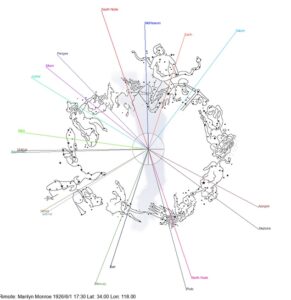
Conversion of the birth data of Marilyn Monroe to StarBase
StarBase, the custom-made software for Celestics, automatically converts the birth data of the horoscope to this format. It uses a graphic template called the Rimsite: the circular array of figures seen (sighted) and located (sited) on the ecliptic. This is a visual model of the real-sky constellations calibrated by exact star positions within the zodiacal figures. I have long preferred to render the graphics in a Modernist style of line-drawing typical of Matisse, Klimt, and others.
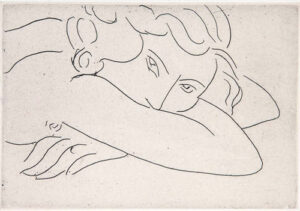
With the Rimsite, what you see is what you get. And what you get eliminates the constructive clutter of signs, houses, and aspects in the horoscope. It retains only the planets, showing projective lines to each one. Note the Sun on the line that crosses the forehead of the celestial Bull (not Taurus!). Opposite, Earth defines the line that runs past the large star in the Scorpion (not Scorpio!). Monroe was born with Earth in the heart of the Scorpion. If you know anything about her life, that trope might strike a poignant note for you, even before you learn what it means. There is a lot to be learned from a forensic study of the manifold of Marilyn Monroe.
Scan the Rimsite and see if you can find other planets in other locations. Can you find Mars in the body of one of the Fishes (not Pisces), pictured as Whales? Notice how one Whale swims along the ecliptic rim while the other leaps up from it. This is how whales actually behave. They leap upward and they dive or “sound,” plunging into the depths of the ocean. The one on the left (east) is called the Eastern Whale, and the one on the right (west) is called the Western Whale. Notice that they do not move opposite each other, but at right angles.
In sidereal mythology, each constellation encodes a range of mythic narratives, themes, memes, motifs, plots and actors including heroes and heroines and divine or superhuman powers. This rich and diverse repertoire is called the inventory. There are summary themes for all constellations, usually capitalized. For the Eastern Whale, the summary themes are Antiquity, Origins, Sacred Wisdom. For the Western Whale, they are Modernity, the Future, Acquired Wisdom. Obviously, these are grand tropes that can be extrapolated in various ways. They are universal themes of human experience, archetypal trends, as they might be called.
Manifold items “loaded” into the star-patterns reveal how you participate in the evolution of these trends. This participation is a process of psycho-emotional immersion and creative emergence. It grows from the deep matrix of human striving over long periods of time. When you realize your involvement in these enduring themes, you reach a dimension of self-awareness that is sublime and transcendental. You see the pattern of your life in a way that surpasses your singular ego-centered identity as an actor in the social order. You see yourself as the beneficiary of the passions, heroic efforts, creative projects, moral inspirations, and noble ideals of those who lived before you and left the record of their experience in the 95% of non-chromosomal DNA of the human genome.
Look at the relative size of the Whales compared to other figures. The extent of this constellation on the ecliptic is 42 degrees. It is the second largest constellation after the Virgin which is located opposite to it. The extent of the Virgin is 45° or more, depending on how you observe the lower boundary of her body-veil. A scan of the Rimsite reveals that the sizes and shapes of the star-patterns vary considerably. They also appear to be interactive. To the right (west) of the Western Whale is the Manitu, a majestic figure holding an urn with its right hand. Imagine water streaming from the urn and producing currents, then picture the Western Whale swimming into those currents. Then again, notice how the left arm of the Manitu extends over the next constellation, the Goatfish, and seems to be pointing or guiding it on its way.
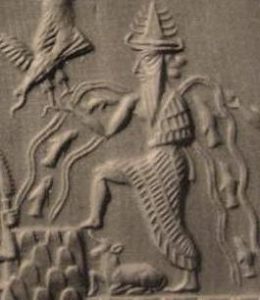
The Manitu is a name for the constellation traditionally identified as Aquarius (a sign name again!), called the Waterbearer, often associated with the Sumerian god of the sweet water paradise, Enki. It is widely believed that the next great epoch of human evolution is the “Aquarian Age,” but the dawn of this future era cannot be computed from the sign Aquarius. It has to be calculated in star-time from the composites of the Western Whale and the Manitu. The Western Whale (Future) swims toward the Manitu (Guiding Spirit). Image to the right: Sumerian tablet picturing Ea or Enki.
Keep looking and you see the Goatfish (not Capricorn) to the right of the Manitu whose left arm extends over it, as if pointing out its way, guiding it. The extent of the Goatfish is only about 22° on the ecliptic, nearly half of that of the Whales. Scanning further, you see that the Scales or Balance (at the two o’clock position) and the Crab (five o’clock position) are also diminutive figures, only around 20 to 22 degrees in extent. Almost all the ecliptic constellations are interactive. The Scorpion reaches out with its left claw and jounces the crossbeam of the Scales, knocking the pans awry. What on Earth does that mean? Every celestial picture tells a story and every mythic image is worth a thousand words. Know it or not, believe it or not, your life-narrative is encrypted within these images and words.
Even before you learn about the thematic content specific to each of the zodiacal images, the simple act of picturing them discharges a rush of associations in your imagination — defined in psychology today as a “psychogenic fugue.” Contrast this experience to the blank stare of looking at a horoscope. You see the structure in four parts, but that tells you nothing without the technique of interpretation. What you see in the manifold projected into the Rimsite immediately downloads into your psyche and triggers a range of emotional and mental signals. Or at least it can, if your psyche is still alive, charged with animating power, and not stymied by external optical input, zombified by virtual media.
C. G. Jung initially defined what has come to be known as an “archetype” (German urbild, “primordial image”) in a different way. He called it a “feeling-toned complex” or “psychic constellation.” Each zodiacal image carries a distinct emotional tone. Bull, Lion, and Virgin invoke different strains of the psychogenic fugue. (I prefer the term mythophrenic fugue.) They activate the primordial images inherent to the human psyche and common to everyone, although they configure in different ways for different individuals.
Celestial Engrams
Why does this happen in this way? The stories living in the sky for all to see mirror the neurological circuits of the human animal. As without, so within. The term engram is interchangeable with constellation. The primordial images in the sky mirror and interact with engrams in the human psyche. When you behold these images, either in the night sky or rendered graphically in the Rimsite, they immediately mirror and activate neural circuits in your brain. A constellation in the starry heavens is not exclusively out there. It is an engram running in the neural-optical-linguistic matrix of your brain. Realize that, and you get what the optics of forensic astronomy is all about. The zodiacal images are synoptic patterns operating in what I called in, Quest for the Zodiac, the neuro-stellar continuum.
Jung discovered the psychic engrams by word-association tests he conducted early in the 20th century at the Burgholzli clinic in Zurich. He triggered his subjects with specific words and then observed the chain of thoughts, feelings, and images they aroused — in other words, by free association. This exercise carries over into a technique of Celestics but with a distinct difference. When you investigate your manifold, you engage in a process of free association guided by the themes and plot-lines of the constellations. In that way, you are actually tracking the engrams that operate imaginatively in your psyche, and materially in your neurological circuits. This process is not entirely random because the psychic constellations in their entirety — the 16 code-lines in the manifold — are coherently integrated like the clues and directions of a treasure-map leading to your purpose.
The various themes, memes, narratives and plot-lines in the inventory of the constellations stand before you in an immense tableaux in the sky, encoded with stories that interweave where the zodiacal figures interact. In Celestics, you learn these stories and how they apply to the way you compose your life-narrative. Doing so, you draw upon the power and beauty of mythic animations that transcend the limits of your self-defined personal identity.
Let’s return to Marilyn Monroe for a moment. “Earth in the heart of the Scorpion” identifies a distinct narrative theme in her life story. It reveals what she told herself about what she was doing and what she aspired to do. It does not explain how and why she behaved by the use of psycho-analytic language. I cannot stress strongly enough that Celestics is a tool of biographic investigation, not a technique of psychological interpretation. You can analyze Marilyn Monroe in any way you like, using the psychological method of your choice (Freudian, Jungian, Reichian, etc), but in forensic astronomy you investigate the composition of her life-narrative, not the profile of her personal attitudes, tendencies, syndromes and complexes.
And you do the same for yourself. Needless to say, many rich and stunning insights into your psychological make-up will come to your attention in this practice. But they are side-effects, not the central objective of the practice. The objective is to become self-aware in composing your life-narrative to the extent that you master it. You script your life-story and learn now to test and demonstrate it so that you attain the optimal level of self-expression as a sovereign, self-directing individual.
Marilyn Monroe is one of the many biographic cases to be investigated on Celestics.org. The inclusion of Earth in the manifold is one of the first details to be considered in every case, including your own. In forensic astronomy, Earth designates purpose, understood to mean the truth on which you stand and the fulfilment of what you love to do. “Earth in the heart of the Scorpion” is the meme for purpose in the example of Marilyn Monroe. Fine, clear enough, but how did she achieve it? Or did she achieve it at all in the way she told herself she wanted to?
One of the themes of the Scorpion is sexual-romantic bonding in the life-long commitment to one partner who shares your deepest passions and aspirations. This theme goes to the classic precedent of “love-death” in the medieval legend of Tristan and Isolde. By another track in the psychogenic fugue, it goes to the myth of Orpheus and Eurydice. These narratives are among the most powerful and long-enduring love stories in the world. They encode “feeling-toned” complexes of tragedy, but also of sublime and captivating beauty. You get to know Marilyn Monroe intimately when you look into the deep matrix of her psyche displayed in the Rimsite. Then you see that although she came to be known for the beauty of her face and figure, not to mention her ingenuous and often comedic characters, she strove to achieve her purpose in life on other terms.
Treasure Trove
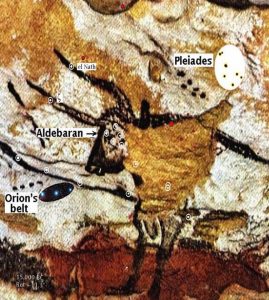
Cave painting of the Bull at Lascaux in southwestern France
I have compared the 16 entries in the manifold to clues and directions on treasure map. The adventure of life that you pursue with passion (Sun) toward an enduring contribution (Earth) is a treasure trail. Along the way, you find that the clues you are tracking belong to a repository of diverse artifacts, megalithic structures, cave art, petroglyphs, sacred inscriptions, works of science, art and music, and textual evidence of the long trajectory of human striving that unfolded before you were born. The treasure trail is simply a vein in this treasure trove. But it is your unique vein to be mined for all its richness.
The cave painting of the Bull at Lascaux, one estimate of the date of this prehistoric work is art (for what it’s worth) is 17,000 years ago. That image of cosmic animation combines the representation of a living animal with the mirroring figure in the sky. Add to that the optical effect registered in human neurological circuits.
This issue of the inheritance of psychic archetypes is the great unsolved problem of modern psychology. Do I claim to have solved it? I could say, yes, absolutely, but I prefer to present the evidence of that proof for you to verify for yourself. To do so, I rely on the evidence from my own manifold and many others, as well. My manifold shows the Earth (purpose) in the eye of the Bull, marked by the bright star, Aldebaran @ 71° in 11 Gemini. Same locale as Monroe’s Sun. (This is called a local flush of manifold entries, explained elsewhere.) I have been to Lascaux and seen that cave painting. I have also been at the temple of Hathor at Dendera in upper Egypt where you see the Mother Goddess represented in many ties over in the bovine imagery. You might be intrigued to know that there is a deep mystery in the conflation of bovine imagery (cow) with the presumed masculine power of the male counterpart, the taurine animal, the bull. Hold on a moment longer while I offer a glimpse of the treasure trove that I discovered on my own treasure hunt, in Vocation.
© John Lamb Lash 2025. All rights reserved
